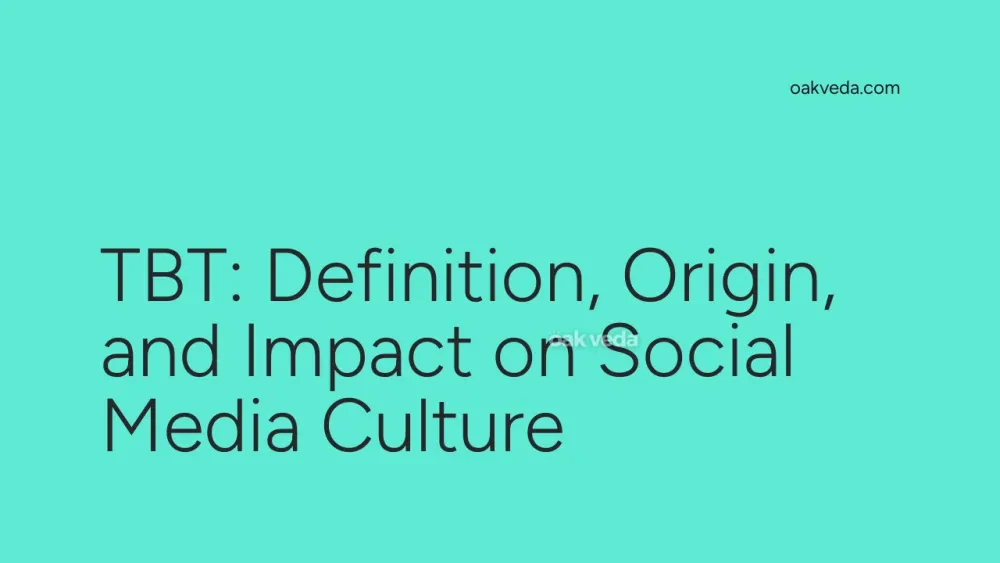
What is TBT?
TBT, an acronym for "Throwback Thursday," is a widely popular social media trend that encourages users to share nostalgic content from their past. This phenomenon has become a cultural touchstone in the digital age, allowing people to reminisce, connect, and celebrate memories across various social platforms.
Origin and Development of TBT
The concept of Throwback Thursday originated in the early 2010s on Instagram, quickly spreading to other social media platforms like Facebook, Twitter, and TikTok. Initially, TBT was strictly observed on Thursdays, but its popularity has led to a more flexible approach, with users sharing throwback content throughout the week.
How TBT Works
Participating in TBT is simple and engaging:
- Choose a memory: Select a photo, video, or story from your past.
- Share on social media: Post the content on your preferred platform.
- Use the hashtag: Include #TBT or #ThrowbackThursday in your post.
- Add context: Provide a caption explaining the significance of the memory.
- Engage with others: Like, comment, and interact with other TBT posts.
Types of TBT Content
TBT posts can encompass a wide range of nostalgic content:
- Personal memories: Childhood photos, old family pictures, or past events
- Pop culture references: Vintage TV shows, movies, or music
- Historical events: Significant moments in history or local community milestones
- Fashion throwbacks: Old styles, trends, or personal fashion choices
- Technological nostalgia: Outdated gadgets, software, or websites
Popular Examples of TBT
Celebrities, brands, and everyday users have embraced TBT, creating some memorable posts:
- Celebrity transformations: Stars sharing their early career photos or childhood pictures
- Brand evolution: Companies showcasing their first products or original logos
- Historical milestones: News outlets revisiting significant events from the past
- Before-and-after: Users comparing their past and present selves
Impact of TBT on Social Media Culture
TBT has significantly influenced social media culture in several ways:
- Fostering nostalgia: Encouraging users to reflect on and appreciate their past experiences
- Building community: Creating shared experiences and connections through collective memories
- Driving engagement: Providing a consistent, weekly theme for content creation and interaction
- Humanizing brands: Allowing companies to show their history and connect with audiences on a personal level
- Preserving memories: Motivating users to digitize and share old photos and videos
How Brands and Influencers Use TBT
Marketers and influencers have leveraged TBT to enhance their social media strategies:
- Storytelling: Using past events to craft compelling narratives about brand evolution
- Product revival: Reintroducing discontinued products or services based on nostalgic demand
- Customer loyalty: Strengthening emotional connections by sharing company history
- User-generated content: Encouraging followers to share their own throwback experiences with the brand
- Cross-promotion: Collaborating with other brands or influencers to create themed throwback content
Future Trends Related to TBT
As social media continues to evolve, so does the concept of TBT:
- AI-enhanced throwbacks: Using artificial intelligence to colorize old photos or enhance video quality
- Virtual reality experiences: Creating immersive throwback environments for users to explore
- Personalized nostalgia: Leveraging user data to suggest relevant throwback content
- Cross-platform integration: Seamlessly sharing throwback content across multiple social media platforms
- Augmented reality filters: Developing AR filters that transform current photos into vintage-style images
FAQs about TBT
Q: Does TBT have to be on Thursday? A: While TBT originated as a Thursday tradition, it has become more flexible. Users now share throwback content throughout the week, although Thursday remains the most popular day for TBT posts.
Q: How far back should a TBT post be? A: There's no strict rule, but generally, TBT posts feature content from at least a few years ago. The key is to share something that evokes nostalgia or showcases a significant change over time.
Q: Can businesses use TBT effectively? A: Absolutely! Businesses can use TBT to showcase their company history, highlight product evolution, or share customer success stories from the past. It's an excellent way to humanize the brand and connect with audiences on an emotional level.
Q: Are there any alternatives to TBT? A: Yes, similar trends have emerged, such as "Flashback Friday" (#FBF), "Way Back Wednesday" (#WBW), and "Memory Monday" (#MM). These variations offer more opportunities for sharing nostalgic content throughout the week.
Q: How can I make my TBT posts stand out? A: To create engaging TBT content, focus on sharing authentic, meaningful memories. Add context to your posts, use high-quality images or videos, and engage with your audience by asking questions or encouraging them to share their own related memories.
In conclusion, TBT has become more than just a hashtag; it's a cultural phenomenon that has shaped how we interact on social media. By encouraging users to share and celebrate their past, TBT has created a unique space for nostalgia, connection, and storytelling in the digital age. As social media continues to evolve, the concept of TBT is likely to adapt and remain a beloved tradition for years to come.
You may be interested in:
- Fam: Definition, Origin, and Impact on Social Media
- Shook: Definition, Origin, and Impact on Social Media
- Marketing Proposal: Definition, Origin, and Impact
- Deinfluencing: Definition, Origin, and Impact on Social Media
- Face Card: Definition, Origin, and Impact on Social Media
- A/B Testing: Definition, Origin, and Impact on Social Media

